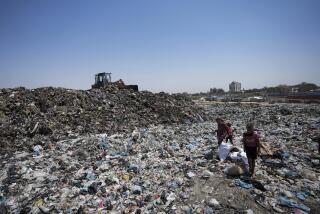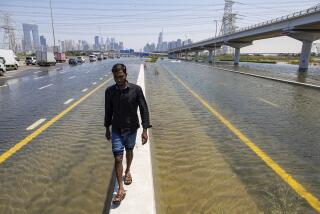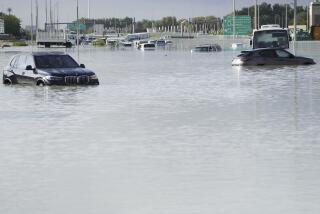Iraq in throes of environmental catastrophe, experts say
BAGHDAD — You wake up in the morning to find your nostrils clogged. Houses and trees have vanished beneath a choking brown smog. A hot wind blasts fine particles through doors and windows, coating everything in sight and imparting an eerie orange glow.
Dust storms are a routine experience in Iraq, but lately they’ve become a whole lot more common.
“Now it seems we have dust storms nearly every day,” said Raed Hussein, 31, an antiques dealer who had to rush his 5-year-old son to a hospital during a recent squall because the boy couldn’t breathe. “We suffer from lack of electricity, we suffer from explosions, and now we are suffering even more because of this terrible dust.
“It must be a punishment from God,” he added, offering a view widely held among Iraqis seeking to explain their apocalyptic weather of late. “I think God is angry with the deeds of the Iraqi people.”
The reality is probably scarier. Iraq is in the throes of what some officials are calling an environmental catastrophe, and the increased frequency of dust storms is only the most visible manifestation.
Decades of war and mismanagement, compounded by two years of drought, are wreaking havoc on Iraq’s ecosystem, drying up riverbeds and marshes, turning arable land into desert, killing trees and plants, and generally transforming what was once the region’s most fertile area into a wasteland.
Falling agricultural production means that Iraq, once a food exporter, will this year have to import nearly 80% of its food, spending money that is urgently needed for reconstruction projects.
“We’re talking about something that’s making the breadbasket of Iraq look like the Dust Bowl of Oklahoma in the early part of the 20th century,” said Adam L. Silverman, a social scientist with the U.S. military who served south of Baghdad in 2008.
So fragile has the environment become that even the slightest wind whips up a pall of dust that lingers for days.
Sandstorms are a naturally occurring phenomenon across the region, but the accumulation of dust on the surface of Iraq’s dried-out land has exacerbated the problem, leading to more frequent and longer-lasting storms, said Army Lt. Col. Marvin Treu, chief of the U.S. military’s Staff Weather Office.
This summer and last have seen more than twice as many dusty days as the previous four, he said. And 35% of the time, dust is reducing visibility to less than three miles, the point at which it is normally considered unsafe to fly. On many of those days, visibility was zero, delaying flights, disrupting military operations and sending thousands of people to hospitals with breathing problems.
“The lack of available water is a huge issue and it’s having a huge effect on Iraqi society,” said Silverman, social science advisor for strategic communications with the Army’s Human Terrain System, a program that links social scientists and anthropologists with combat brigades. He emphasized that he was not speaking on behalf of the military.
It’s a dramatic turnaround for the country where agriculture reputedly was born thousands of years ago. Iraq’s ancient name, Mesopotamia, means “Land Between the Rivers,” and though about half the country traditionally has been desert, the fertile plains watered by the mighty Tigris and Euphrates rivers once provided food for much of the Middle East.
Now the Agriculture Ministry estimates that 90% of the land is either desert or suffering from severe desertification, and that the remaining arable land is being eroded at the rate of 5% a year, said Fadhil Faraji, director-general of the ministry’s Department for Combating Desertification.
“Severe desertification is like cancer in a human being,” he said. “When the land loses its vegetation cover, it’s very hard to get it back. You have to deal with it meter by meter.”
It’s difficult to know where to begin to untangle the complex web of factors that have conspired to push Iraq to this point. But officials say human error is primarily to blame.
It hasn’t been scientifically proved that tank movements in the desert have helped stir up the dust, as many Iraqi experts believe. But other factors are not in dispute.
In the quest to bolster food production, farmers have been encouraged by the government to till marginal land. When it fails, they abandon it, leaving it cleared of its natural vegetation.
Chronic electricity shortfalls also have played a role. People chop down trees for firewood, leaving more bare land, and the shortage of power has made it difficult to pump water through the irrigation channels that had sustained fertile lands far beyond the rivers. Compounding the already dire shortages, power stations have been forced to shut down for days at a time because they lack water.
Then came the regionwide drought that has dramatically depleted the amount of water available. Last year’s rainfall was 80% below normal; this year only half as much rain fell as usual.
Turkey and Syria, which control the headwaters of the Euphrates, have curtailed the river’s flow by half to deal with their own drought-related problems, said Awn Abdullah, head of the National Center for Water Resources Management.
Water has been diverted from the Tigris to keep the Euphrates flowing, causing problems for communities along that river. Iran, too, has been building dams on tributaries of rivers that reach into Iraq, drying out riverbeds in the east of the country.
The effects extend far beyond the immediate inconveniences of dust storms. Drinking water is scarce in many areas of the south as seawater leaches into the depleted rivers. The fabled marshes of southern Iraq, drained by Saddam Hussein and then re-flooded after the U.S.-led invasion in 2003, are drying up, and the traditional Marsh Arabs who depend on them for their livelihood are being forced to leave again.
In the cities, rural migrants compete with the urban poor for scarce jobs and resources, and in desperation some turn to crime or insurgency.
And then there are the dust storms, which bring the crisis of the countryside directly into the living rooms of city dwellers. The falling dust has the consistency of talcum powder, and it finds its way into cupboards and corners as well as nostrils and lungs.
“It causes health problems, it disrupts business, it destroys machinery, not to mention the psychological effects,” said Ibrahim Jawad Sherif, who is in charge of soil monitoring at the Environment Ministry. “It’s a catastrophe that’s affecting every aspect of Iraqi life.”
Fixing the problem would require a huge injection of funds and is beyond the capacity of the Iraqi government alone, Environment Minister Narmin Othman said. The country needs international aid to revitalize agriculture and plant trees, she said, as well as help in negotiating water-sharing treaties with Turkey and Syria, which previous governments neglected to do.
Whether it can be resolved is another question, said a Western official involved with efforts to rejuvenate Iraqi agriculture, who spoke on condition of anonymity.
The government has other priorities, he said, and “it’s a question whether they care. . . . It needs such monstrous help, over such a long-term period. You’re talking generations.”
--
More to Read
Sign up for Essential California
The most important California stories and recommendations in your inbox every morning.
You may occasionally receive promotional content from the Los Angeles Times.










